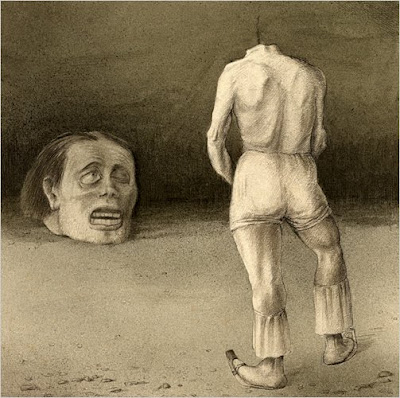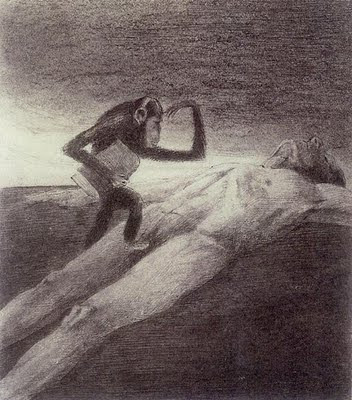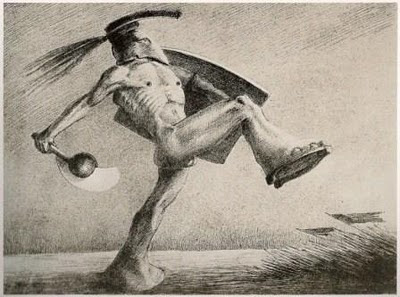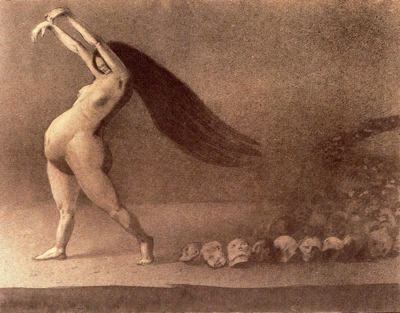Note: The following article was published in late August in the New York Times. It's highly interesting because it runs on two parallel levels, i.e., as a "straight" account of an important scientific discovery and also as a tale of professional jealousy. I've tried to demarcate the two levels by assigning them different color type here, but basically it's a story worth reading and information worth knowing.
Acollection of tubular microfossils found in 3.4-billion-year-old sandstone fromWestern Australia (photograph: David Wacey)
By:NICHOLAS WADE
A team of Australian and Britishgeologists have discovered fossilized, single-cell organisms that are 3.4billion years old and that the scientists say are the oldest known fossils onearth.
Their assertion, if sustained,confirms the view that life evolved on earth surprisingly soon after the Late Heavy Bombardment, a reign of destruction in which waves of asteroids slammedinto the primitive planet, heating the surface to molten rock and boiling theoceans into an incandescent mist. The bombardment, which ended around 3.85billion years ago, would have sterilized the earth’s surface of any incipientlife.
The claim is also a new volley in along-running conflict over who has found the oldest fossil.
The new microfossils are describedin Sunday’s issue of Nature Geoscience by a team led by David Wacey of theUniversity of Western Australia and Martin D. Brasier of the University of Oxford. The fossils were found in sandstone at the base of theStrelley Pool rock formation in Western Australia.
The sandstone, 3.4 billion yearsago, was a beach on one of the few islands that had started to appear above theocean’s surface. Conditions were very different from those of today. The moonorbited far closer to earth, raising huge tides. The atmosphere was full ofmethane, since plants had not yet evolved to provide oxygen, and greenhousewarming from the methane had heated the oceans to the temperature of a hotbath.
It was in these conditions, thegeologists believe, that organisms resembling today’s bacteria lived in thecrevices between the pebbles on the beach. Examining thin slices of rock underthe microscope, they have found structures that look like living cells, some inclusters that seem to show cell division.
Cell-like structures in ancientrocks can be deceiving — many have turned out to be artifacts formed bynonbiological processes. In this case, the geologists have gatheredconsiderable circumstantial evidence that the structures they see arebiological. With an advanced new technique, they have analyzed the compositionof very small spots within the cell-like structures. “We can see carbon,sulfur, nitrogen and phosphorus, all within the cell walls,” Dr. Brasier said.
Crystals of fool’s gold, aniron-sulfur mineral, lie next to the microfossils and indicate that theorganisms, in the absence of oxygen, fed off sulfur compounds, Dr. Brasier andhis colleagues say.
Microfossils — the cell-like structuresfound in ancient rocks — have become a highly contentious field, both becauseof the pitfalls in proving that they are truly biological and because thescientific glory of having found the oldest known fossil has led to pitchedbattles between rival claimants.
Microfossils discovered in Western Australia by J. William Schopf, University of California, Los Angeles. A photograph of each specimen appears with an interpretive drawing of the structure. (Photograph courtesy of J. William Schopf).
The honor of having found the mostancient microfossil has been long been held by J. W. Schopf, a paleobiologistat the University of California, Los Angeles. In 1993, Dr. Schopf reported his discovery of fossils 3.465 billion yearsold in the Apex chert of the WarrawoonaGroup in Western Australia, about 20 miles from where the new fossils have beenfound. Those would be some 65 million years older than the new find, but Dr.Schopf’s claim was thrown in doubt in 2002 when Dr. Brasier attackedhis finding, saying the fossils were notbiological but just mineral artifacts.
With the new discovery, Dr. Brasierhas dropped the second shoe, claiming to find microfossils that are or may bethe oldest known, if and when Dr. Schopf’s are knocked out of the running.
The Nature Geoscience articlepublished on Sunday does not claim discovery of the earth’s oldestmicrofossils. That assertion was made in a press release issued by theUniversity of Oxford, where Dr. Brasier is a professor in the department ofearth sciences.
Dr. Brasier said the articlesubmitted to Nature Geoscience had made such a claim, but the reviewersquestioned the advisability of doing so, and the senior author, Dr. Wacey,“decided to acquiesce on this particular point.”
Dr. Schopf did not respond to ane-mail seeking his comments. “Bill Schopf still very strongly defends hisoriginal claim, and is working to validate it,” said Roger Buick, an earthscientist at the University of Washington.
Dr. Buick said there was noconsensus on Dr. Schopf’s microfossils, but that “the majority opinion is that they are probably not biological and probably not as old as claimed.”
The team led by Dr. Wacey and Dr.Brasier has made a “pretty good case,” Dr. Buick said, because the manydifferent analytic techniques they have used “lend credence to the argument ina way that many other previously reported discoveries of particularly ancientmicrofossils have not.”
Does that mean the new microfossilsare the oldest known? “If these are valid, and if we discount the Schopfmicrofossils, these would be the oldest known, though not by much,” Dr. Buicksaid.
Artist's rendering of Earth during the Archean eon, i.e., 2.5 billion years ago. (Peter Sawyer, Smithsonian Institution).
Rocks older than 3.5 billion yearshave been so thoroughly cooked as to destroy all cellular structures, butchemical traces of life can still be detected. Chemicals indicative of lifehave been reported in rocks 3.5 billion years old in the Dresser Formation ofWestern Australia and, with less certainty, in rocks 3.8 billion years old inGreenland.
“This struggle to be the owner ofthe world’s oldest microfossils is really not the crux of the battle forunderstanding the early development of life anymore,” Dr. Buick said.
Andrew H. Knoll, an earthscientist at Harvard, said in a brief e-mail from a Moscow airport that theresearchers had not proved their point that the fossils, when alive, fed onsulfur compounds. But he did not take sides on the dispute between Dr. Brasierand Dr. Schopf.
Dr. Buick said: “You’ve got torealize how divisive this microfossil war has been over the last decade. Mostpeople just want it to be over. If claim and counterclaim go back and forth fora decade, it sounds like we don’t know what we’re doing.”
Ship's chronometer used on HMS Beagle during Charles Darwin's 1831 - 1836 voyage. This instrument was made by Thomas Earnshaw (1749-1828) and is on permanent display in Rooms 38-39 (Clocks and Watches) of the British Museum, London.



















































































































































